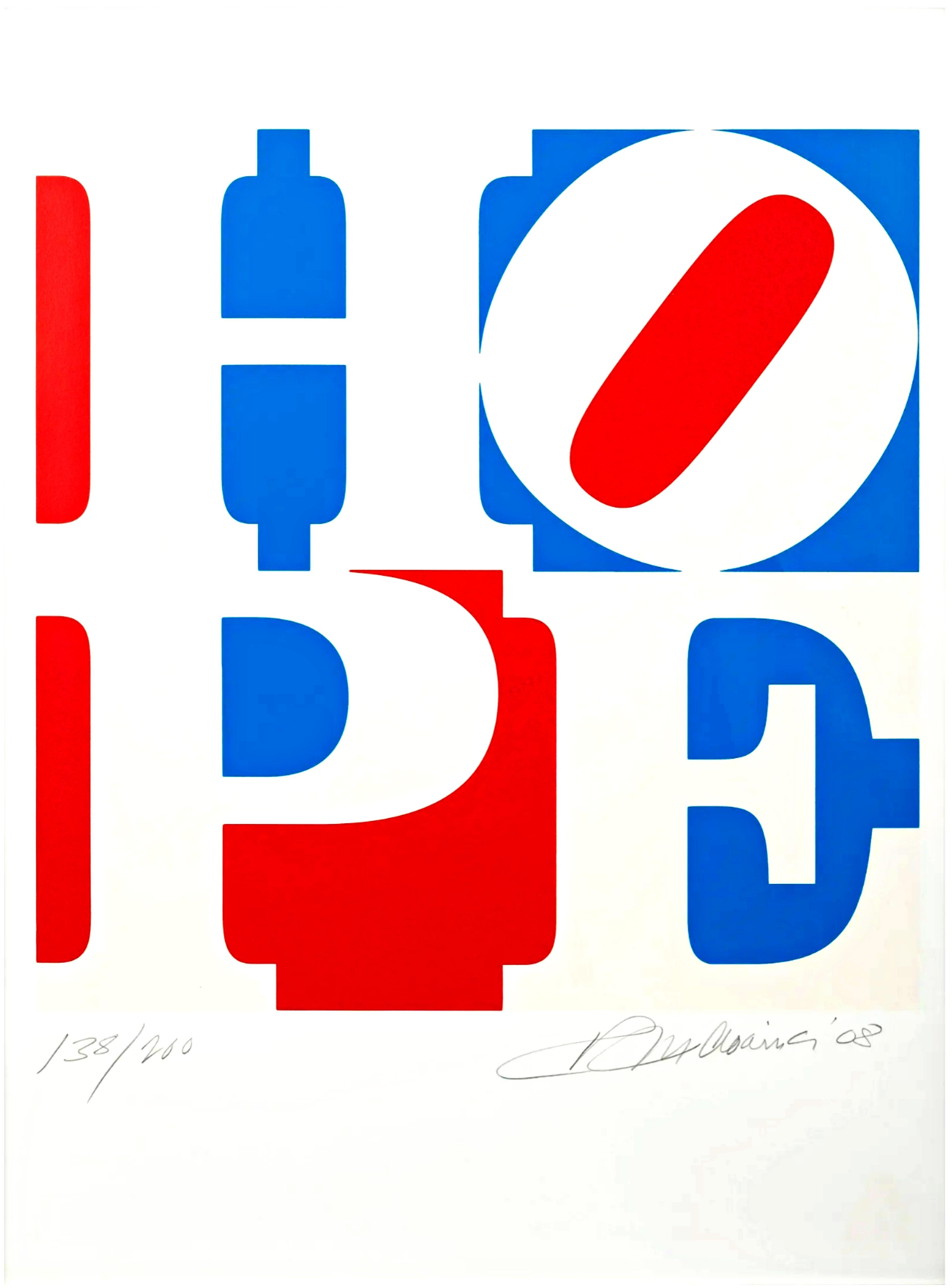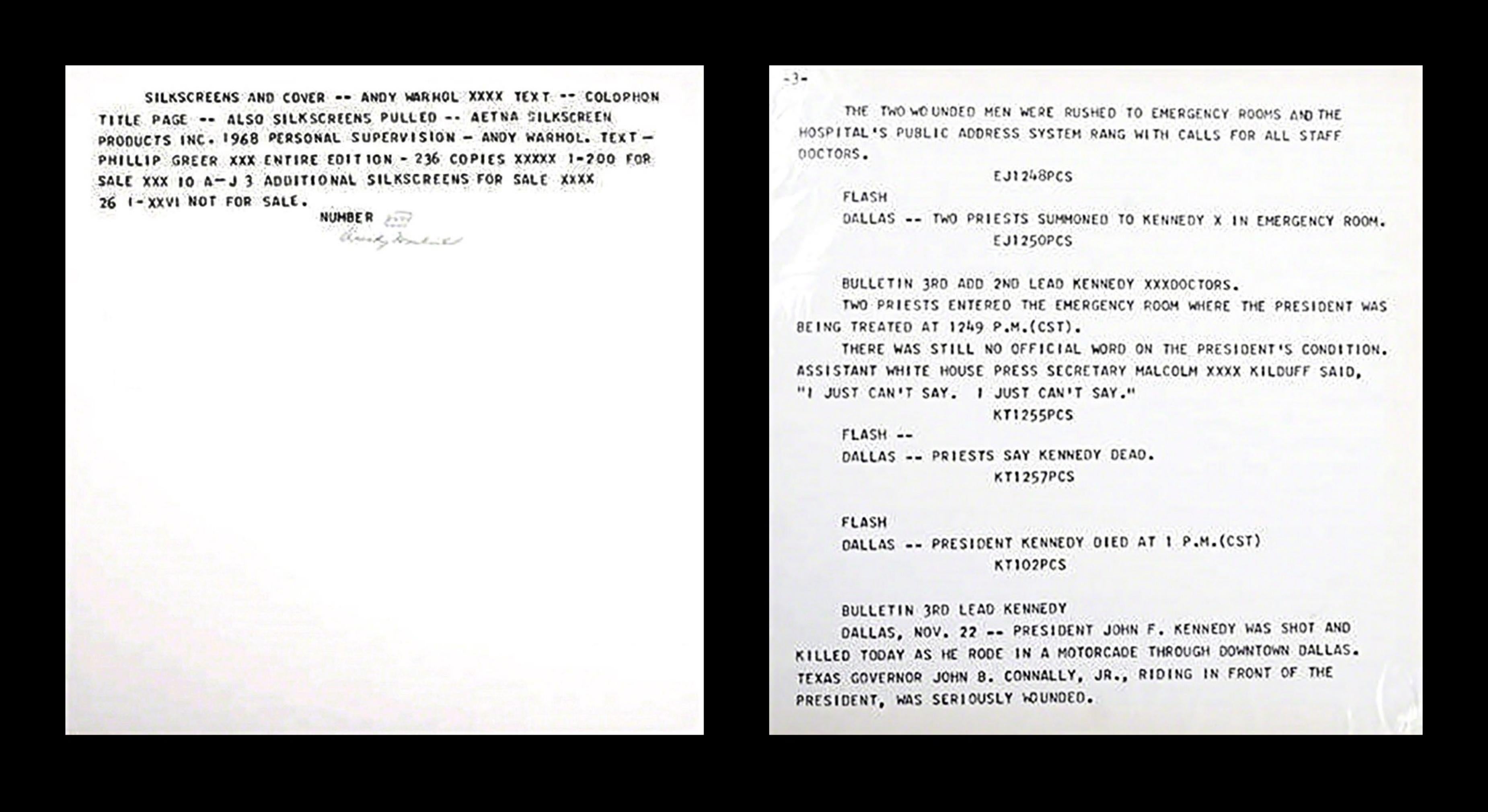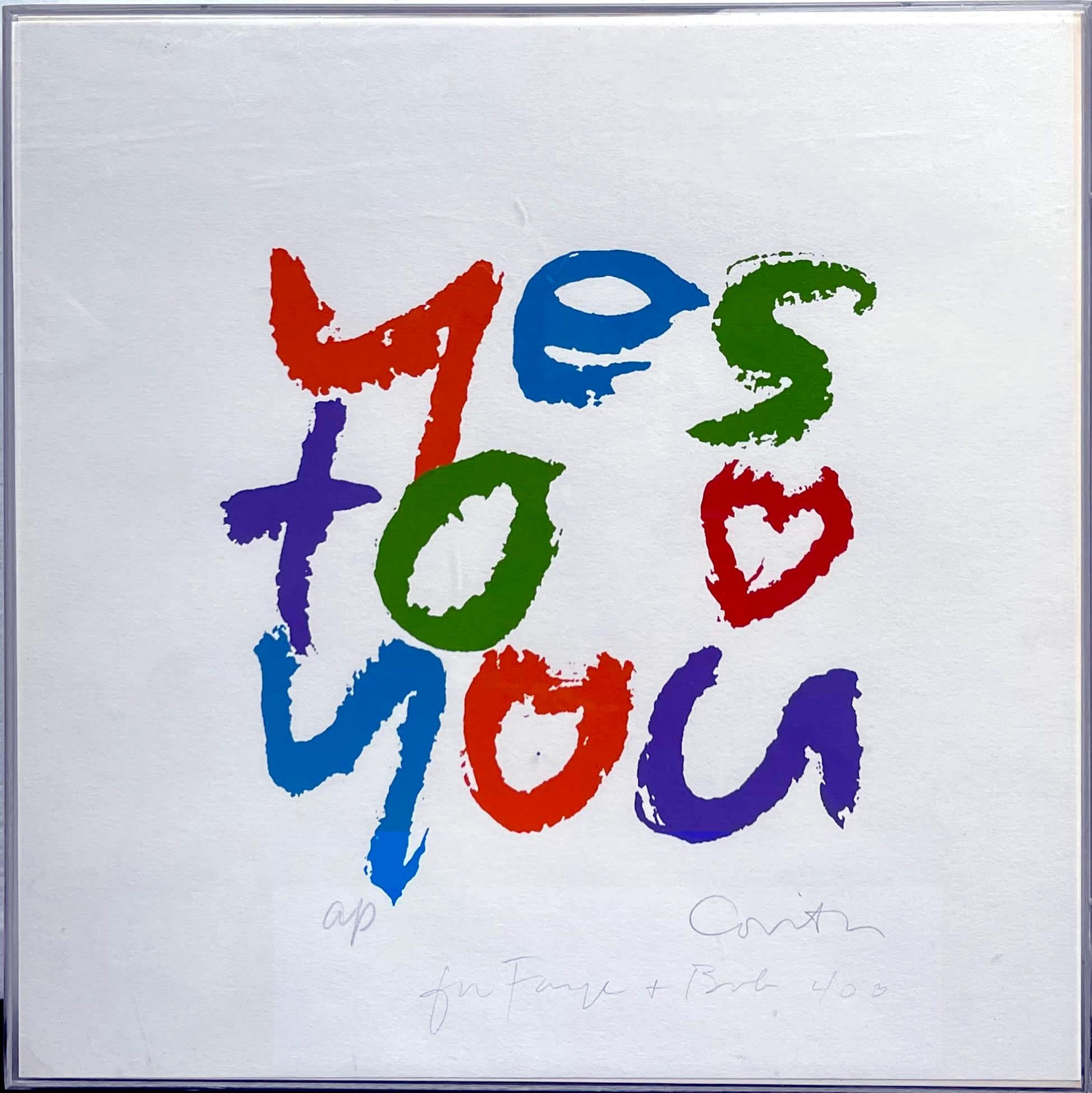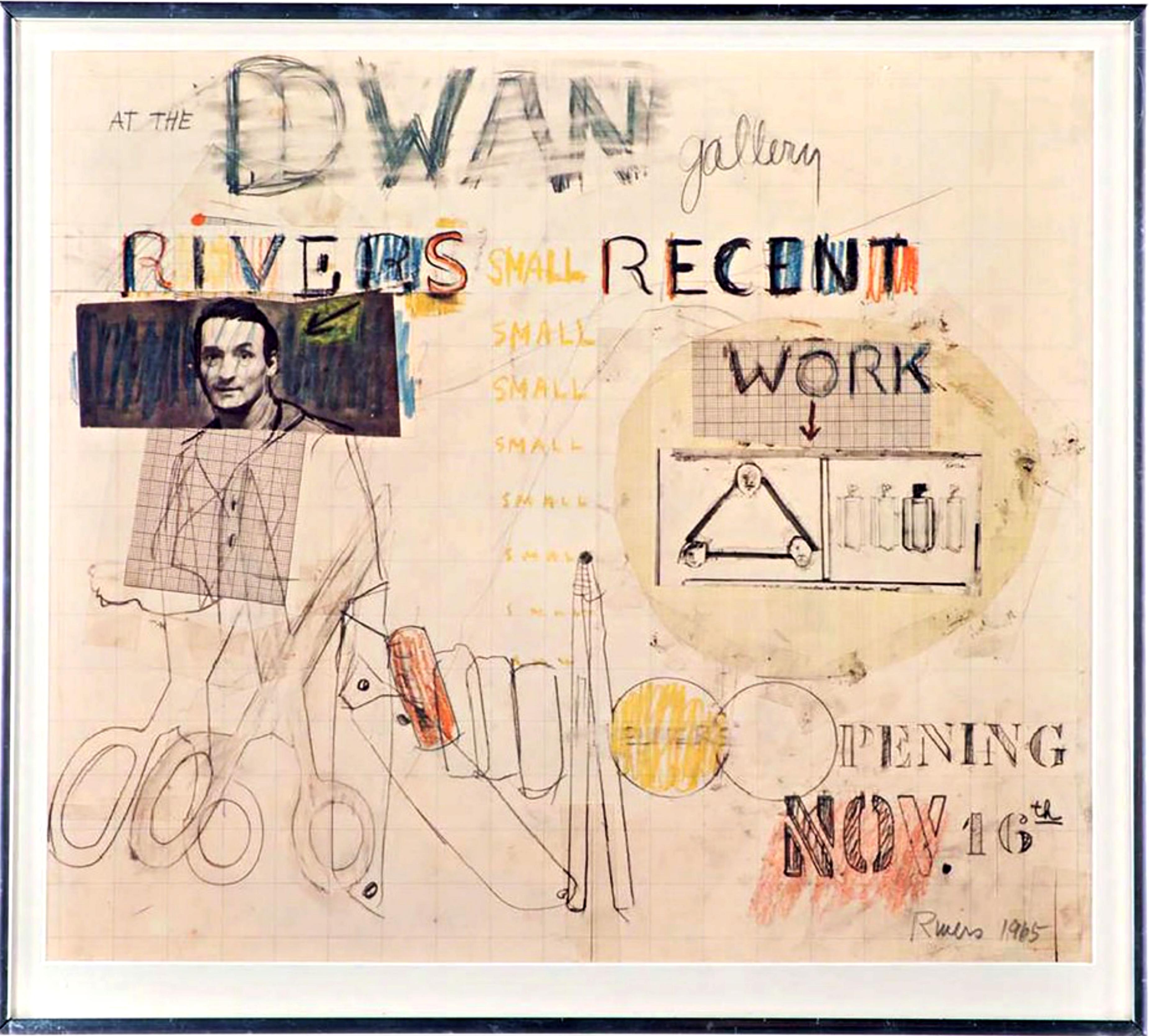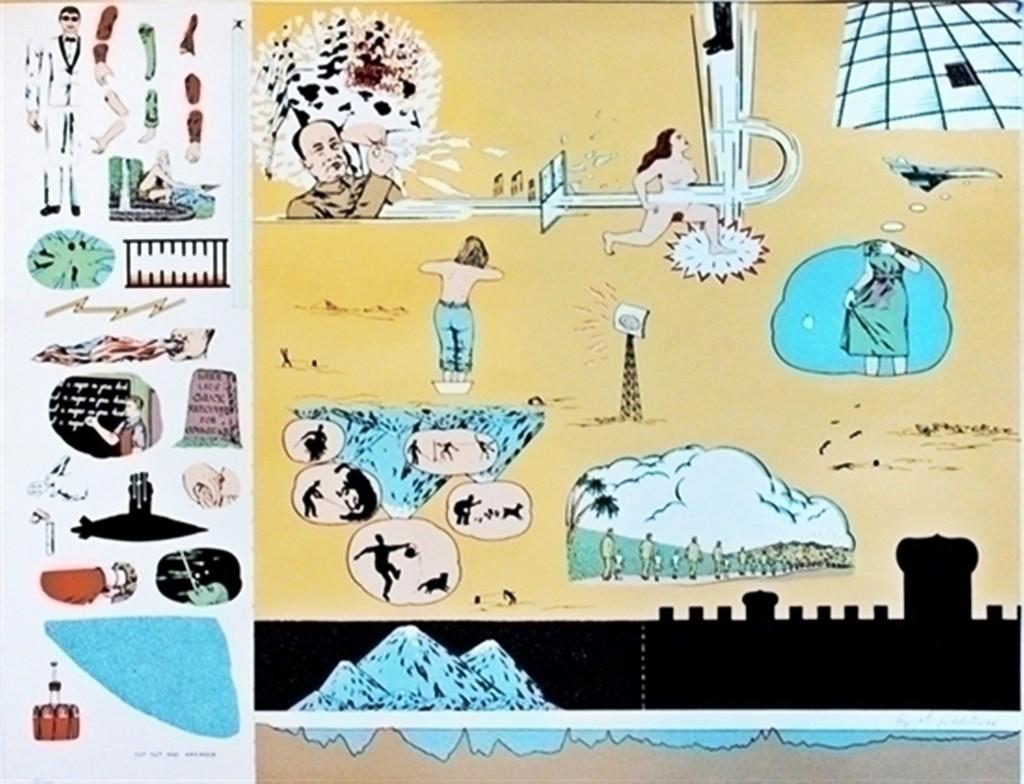Robert IndianaThe Golden Future of America (Sheehan, 92)1976
1976
About the Item
- Creator:Robert Indiana (1928 - 2018, American)
- Creation Year:1976
- Dimensions:Height: 30.5 in (77.47 cm)Width: 25 in (63.5 cm)Depth: 1.5 in (3.81 cm)
- Medium:
- Movement & Style:
- Period:
- Condition:The work is elegantly matted and framed in a wood frame and it ships framed.
- Gallery Location:New York, NY
- Reference Number:1stDibs: LU1745211615592
Robert Indiana
Robert Indiana's work evolved into hard-edged graphic images of words, logos and typographic forms, earning him a reputation as one of the country's leading contemporary artists.
Indiana is known for using public signs and symbols with altered lettering to make stark and challenging visual statements. In his prints, paintings and constructions, he gave new meaning to basic words like Eat, Die and Love. Using them in bold block letters in vivid colors, he enticed his viewers to look at the commonplace from a new perspective. One indication of his success was the appearance of his immensely popular multi-colored Love on a United States postage stamp in 1973.
Find a collection of original Robert Indiana art today on 1stDibs.
- ShippingRetrieving quote...Ships From: New York, NY
- Return PolicyA return for this item may be initiated within 1 day of delivery.
- HOPE, signed and numbered silkscreen from Artists for Obama portfolio 138/200By Robert IndianaLocated in New York, NYRobert Indiana HOPE for the Democratic National Committee, 2008 Oil silkscreen in colors on watermarked Coventry archival paper 25 × 19 inches Edition 138/200 Signed, dated and numbered 138/200 in graphite pencil on the front; paper is watermarked by AIA with text (There were also 25 Artist's Proofs) Published by American Image Art (AIA) for the Obama Victory Fund and the Democratic National Committee, master printer Gary Lichtenstein Unframed This work was published in 2008 as part of the "Artists for Obama" portfolio, in which some of the top artists contributed prints to raise money for Obama's presidential campaign. Robert Indiana donated all of the proceeds of the sale of this work to electing Barack Obama. During the 2020 election, it became an even greater part of American popular culture when it was featured on the influential NBC show Saturday Night Live's cold open skit featuring the Vice Presidential debate between Kamala Harris and Mike Pence. Mid-debate, "Joe Biden" (played by actor Jim Carrey...Category
Early 2000s Pop Art Abstract Prints
MaterialsScreen, Pencil
- Flash portfolio colophon page, JFK Assassination (Hand signed)By Andy WarholLocated in New York, NYAndy Warhol Flash portfolio colophon pages, JFK Assassination, 1968 2 Separate Silkscreens: (1) Silkscreen text on paper and teletype text; (2) colophon sheet in pencil and numbered XVII (from the edition of 26 (roman numerals) Hand-signed by artist, two silkscreen prints; the colophon sheet is hand signed by Andy Warhol; no signature on sheet with teletype 21 1/2 × 21 1/2 inches Unframed Note: measurements are for each sheet Catalogue Raisonne Reference: FS II.32-42 (not illustrated) Silkscreened colophon sheet of the edition XVII of the iconic "Flash" Portfolio; hand signed and uniquely numbered by Andy Warhol, plus silkscreened print with teletype text. These two prints from Warhol's iconic "Flash Portfolio" were selected for inclusion in the blockbuster Andy Warhol retrospective at the Whitney Museum in 2019. (see photos). The plaque on the Whitney exhibition (also see included photo) describes the portfolio as follows:" These screenprints reflect Warhol's ongoing interest in the Kennedy assassination, an obsession that intensified following the release of the Warren Commission report and the publication of stills from a short home movie of the event, published by bystander Abraham Zapruder. Flash - November 22, 1963 is an unbound Artists Book with text based upon the original Associated Press newswire bulletins. For his illustrations, Warhol appropriated the recurring image of Kennedy from a 1960 campaign poster, and sourced the remaining photographs, including pictures of Lee Harvey Oswald and an ad for the type of rifle used, from Life's [Magazine] sustained coverage of the assassination and its aftermath.." The present sheet begins with the following teletyped text: "THE TWO WOUNDED MEN WERE RUSHED TO EMERGENCY ROOMS, AND THE HOSPITAL'S PUBLIC ADDRESS SYSTEM RANG WITH CALLS FOR ALL STAFF DOCTORS. FLASH DALLAS - TWO PRIESTS SUMMONED TO KENNEDY X IN EMERGENCY ROOM BULLETIN 3RD ADD 2ND LEAD KENNEDY XX DOCTORS TWO PRIESTS ENTERED THE EMERGENCY ROOM WHERE THE PRESIDENT WAS BEING TREATED AT 12:49 P.M. (CST). THERE WAS STILL NO OFFICIAL WORD ON THE PRESIDENT'S CONDITION. ASSISTANT WHITE HOUSE PRESS SECRETARY MALCOLM XXX KILDUFF SAID "I JUST CAN'T SAY. I JUST CAN'T SAY." FLASH -- PRIESTS SAY KENNEDY DEAD. .""" (the text on the page continues; this is just a partial excerpt.) Racolin Press, Briarcliff Manor, New York Two Andy Warhol silkscreens on white wove paper comprising the signed colophon and text pages of his iconic 1968 "Flash" Portfolio, as well as Warhol's wraparound silkscreen of the distinctive teletype text. The colophon page silkscreen is hand signed by Andy Warhol and uniquely numbered XVII in pencil from the edition of 26, which, it expressly states, was not for sale. The second silkscreen sheet features teletype print describing events surrounding the assassination of President John F. Kennedy - the defining event of a generation as contemporaneously re-imagined by the most important Pop artist of the era. Warhol created the "Flash - November 22, 1963" portfolio of prints in 1968 to depict the continuing media spectacle surrounding JFK's assassination. He named the portfolio after the news flash Teletype texts that reported the assassination and its aftermath - the first major news event played out live on TV. The Flash portfolio includes a series of eleven silkscreens depicting President Kennedy smiling broadly, a presidential seal with bullet holes through it, and other symbolic representations of that tragedy. The portfolio's cover includes an image of the New York World-Telegram front page with the headline "President Shot Dead." Warhol used screen printed...Category
1960s Pop Art Abstract Prints
MaterialsScreen, Pencil
- Yes to You, silkscreen, pencil signed Artists Proof with heart (regular ed. 200)By Corita KentLocated in New York, NYCorita Kent Yes to You, 1979 Color silkscreen Hand signed, numbered and uniquely inscribed with a heart doodle by the artist on the front. Artists Proof (aside from the regular editi...Category
1970s Pop Art Abstract Prints
MaterialsScreen, Pencil
- At The Dwan Gallery: Historic exhibition poster (Hand Signed by Larry Rivers)By Larry RiversLocated in New York, NYLarry Rivers At The Dwan Gallery: Rivers Small Recent Work (Hand Signed), 1965 Silkscreen on wove paper Hand signed and dated "Rivers, 1965" in graphite pencil lower right front Fram...Category
1960s Pop Art Abstract Prints
MaterialsScreen, Pencil
- Love Is GodBy Robert IndianaLocated in New York, NYRobert Indiana Love Is God, 2014 Silkscreen on 2 ply Rising Museum Board 32 × 32 inches Hand signed and numbered 33/50 in graphite pencil on ...Category
2010s Pop Art Abstract Prints
MaterialsBoard, Screen, Pencil
- Eddie (Sylvie's Brother) in the Desert (celebrated 1960s silkscreen) Signed/NBy Oyvind FahlstromLocated in New York, NYÖyvind Fahlström Eddie (Sylvie's Brother) in the Desert (from New York International Portfolio), 1966 Silkscreen on wove paper Pencil signed and numbered from the limited edition of ...Category
1960s Pop Art Abstract Prints
MaterialsScreen, Pencil, Graphite
- Deborah Kass Feminist Jewish American Pop Art Silkscreen Screenprint Ltd EditionBy Deborah KassLocated in Surfside, FLDeborah Kass (born 1952) Limited edition geometric abstract lithograph in colors on artist paper. Hand signed and dated in pencil to lower right. 1973. Edition: 102/120 to lower left. Dimensions: sight: 16-3/4" W x 21-1/4" H. Frame: 24-5/8" W x 28-7/8" H. Finding inspiration in pop culture, political realities, film, Yiddish, art historical styles, and prominent art world figures, Deborah Kass uses appropriation in her work to explore notions of identity, politics, and her own cultural interests. She received her BFA in painting at Carnegie Mellon University and studied at the Whitney Museum Independent Study Program and the Art Students League of New York. Deborah Kass (born 1952) is an American artist whose work explores the intersection of pop culture, art history, and the construction of self. Deborah Kass works in mixed media, and is most recognized for her paintings, prints, photography, sculptures and neon lighting installations. Kass's early work mimics and reworks signature styles of iconic male artists of the 20th century including Frank Stella, Andy Warhol, Jackson Pollock, and Ed Ruscha. Kass's technique of appropriation is a critical commentary on the intersection of social power relations, identity politics, and the historically dominant position of male artists in the art world. Deborah Kass was born in 1952 in San Antonio, Texas. Her grandparents were from Belarus and Ukraine, first generation Jewish immigrants to New York. Kass's parents were from the Bronx and Queens, New York. Her father did two years in the U.S. Air Force on base in San Antonio until the family returned to the suburbs of Long Island, New York, where Kass grew up. Kass’s mother was a substitute teacher at the Rockville Centre public schools and her father was a dentist and amateur jazz musician. At age 14, Kass began taking drawing classes at The Art Students League in New York City which she funded with money she made babysitting. In the afternoons, she would go to theater on and off Broadway, often sneaking for the second act. During her high school years, she would take her time in the city to visit the Museum of Modern Art, where she would be exposed to the works of post-war artists like Frank Stella and Willem De Kooning. At age 17, Stella’s retrospective exhibition inspired Kass to become an artist as she observed and understood the logic in his progression of works and the motivation behind his creative decisions. Kass received her BFA in Painting at Carnegie Mellon University (the alma mater of artist Andy Warhol), and studied at the Whitney Museum Independent Study Program Here, she created her first work of appropriation, Ophelia’s Death After Delacroix, a six by eight foot rendition of a small sketch by the French Romantic artist, Eugène Delacroix. At the same time Neo-Expressionism was being helmed by white men in the late Reagan years, women were just beginning to create a stake in the game for critical works. “The Photo Girls...Category
2010s Pop Art Figurative Prints
MaterialsScreen
- Deborah Kass Feminist Jewish American Pop Art Silkscreen Screenprint Ltd EditionBy Deborah KassLocated in Surfside, FLDeborah Kass (born 1952) Being Alive, 2012 nine-color silkscreen, one color blend on 2-ply museum board Image 24 x 24 image. Frame 29 x 29 x 2 inches Edition 1/65 Hand signed and dated in pencil, lower right verso; numbered lower left verso Being Alive is from a vibrant and uplifting body of work entitled Feel Good Paintings for Feel Bad Times. Finding inspiration in pop culture, political realities, film, Yiddish, art historical styles, and prominent art world figures, Deborah Kass uses appropriation in her work to explore notions of identity, politics, and her own cultural interests. She received her BFA in painting at Carnegie Mellon University and studied at the Whitney Museum Independent Study Program and the Art Students League of New York. Deborah Kass (born 1952) is an American artist whose work explores the intersection of pop culture, art history, and the construction of self. Deborah Kass works in mixed media, and is most recognized for her paintings, prints, photography, sculptures and neon lighting installations. Kass's early work mimics and reworks signature styles of iconic male artists of the 20th century including Frank Stella, Andy Warhol, Jackson Pollock, and Ed Ruscha. Kass's technique of appropriation is a critical commentary on the intersection of social power relations, identity politics, and the historically dominant position of male artists in the art world. Deborah Kass was born in 1952 in San Antonio, Texas. Her grandparents were from Belarus and Ukraine, first generation Jewish immigrants to New York. Kass's parents were from the Bronx and Queens, New York. Her father did two years in the U.S. Air Force on base in San Antonio until the family returned to the suburbs of Long Island, New York, where Kass grew up. Kass’s mother was a substitute teacher at the Rockville Centre public schools and her father was a dentist and amateur jazz musician. At age 14, Kass began taking drawing classes at The Art Students League in New York City which she funded with money she made babysitting. In the afternoons, she would go to theater on and off Broadway, often sneaking for the second act. During her high school years, she would take her time in the city to visit the Museum of Modern Art, where she would be exposed to the works of post-war artists like Frank Stella and Willem De Kooning. At age 17, Stella’s retrospective exhibition inspired Kass to become an artist as she observed and understood the logic in his progression of works and the motivation behind his creative decisions. Kass received her BFA in Painting at Carnegie Mellon University (the alma mater of artist Andy Warhol), and studied at the Whitney Museum Independent Study Program Here, she created her first work of appropriation, Ophelia’s Death After Delacroix, a six by eight foot rendition of a small sketch by the French Romantic artist, Eugène Delacroix. At the same time Neo-Expressionism was being helmed by white men in the late Reagan years, women were just beginning to create a stake in the game for critical works. “The Photo Girls” consisted of artists like Sherrie Levine, Cindy Sherman, and Barbara Kruger. Kass felt that content of these works connected those of the post-war abstract painters of the mid-70s including Elizabeth Murray, Pat Steir, and Susan Rothenberg. All of these artists critically explored art in terms of new subjectivities from their points-of-view as women. Kass took from these artists the ideas of cultural and media critique, inspiring her Art History Paintings. Kass is most famous for her “Decade of Warhol,” in which she appropriated various works by the pop artist, Andy Warhol. She used Warhol’s visual language to comment on the absence of women in art history at the same time that Women’s Studies began to emerge in academia. Reading texts on subjectivity, objectivity, specificity, and gender fluidity by theorists like Judith Butler and Eve Sedgwick, Kass became literate in ideas surrounding identity. She engaged with art history through the lens of feminism, because of this theory which “The Photo Girls” drew upon. Kass's work is in the collections of the Museum of Modern Art; Whitney Museum of American Art; Solomon R. Guggenheim Museum; Jewish Museum (New York); Museum of Fine Art, Boston; Cincinnati Museum of Art; New Orleans Museum; National Portrait Gallery, Smithsonian Institution; Fogg Museum, Harvard Art Museums; and Weatherspoon Museum, among others. In 2012 Kass's work was the subject of a mid-career retrospective Deborah Kass, Before and Happily Ever After at The Andy Warhol Museum in Pittsburgh, PA. An accompanying catalogue published by Skira Rizzoli, included essays by noted art historians Griselda Pollock, Irving Sandler, Robert Storr, Eric C. Shiner and writers and filmmakers Lisa Liebmann, Brooks Adams, and John Waters. Kass's work has been shown at international private and public venues including at the Venice Biennale, the Istanbul Biennale, the Museum Ludwig, Cologne, the Museum of Modern Art, The Jewish Museum, New York, the National Portrait Gallery, and the Museum of Fine Arts, Boston. A survey show, Deborah Kass, The Warhol Project traveled across the country from 1999–2001. She is a Senior Critic in the Yale University M.F.A. Painting Program. Kass's later paintings often borrow their titles from song lyrics. Her series feel good paintings for feel bad times, incorporates lyrics borrowed from The Great American Songbook, which address history, power, and gender relations that resonate with Kass's themes in her own work. In Kass's first significant body of work, the Art History Paintings, she combined frames lifted from Disney cartoons with slices of painting from Pablo Picasso, Jasper Johns, Jackson Pollock, and other contemporary sources. Establishing appropriation as her primary mode of working, these early paintings also introduced many of the central concerns of her work to the present. Before and Happily Ever After, for example, coupled Andy Warhol’s painting of an advertisement for a nose job with a movie still of Cinderella fitting her foot into her glass slipper, touching on notions of Americanism and identity in popular culture. The Art History Paintings series engages critically with the history of politics and art making, especially exploring the power relationship of men and women in society. Deborah Kass's work reveals a personal relationship she shares with particular artworks, songs and personalities, many of which are referenced directly in her paintings. In 1992, Kass began The Warhol Project. Beginning in the 1960s, Andy Warhol’s paintings employed mass production through screen-printing to depict iconic American products and celebrities. Using Warhol’s stylistic language to represent significant women in art, Kass turned Warhol’s relationship to popular culture on its head by replacing them with subjects of her own cultural interests. She painted artists and art historians that were her heroes including Cindy Sherman, Elizabeth Murray, and Linda Nochlin. Drawing upon her childhood nostalgia, the Jewish Jackie series depicts actress Barbra Streisand, a celebrity with whom she closely identifies, replacing Warhol's prints of Jackie Kennedy Onassis and Marilyn Monroe. Her My Elvis series likewise speaks to gender and ethnic identity by replacing Warhol's Elvis with Barbra Streisand from Yentl: a 1983 film in which Streisand plays a Jewish woman who dresses and lives as a man in order to receive an education in the Talmudic Law. Kass's Self Portraits as Warhol further deteriorates the idea of rigid gender norms and increasingly identifies the artist with Warhol. By appropriating Andy Warhol's print Triple Elvis and replacing Elvis Presley with Barbara Streisand’s Yentl, Kass is able to identify herself with history’s icons, creating a history with powerful women as subjects of art. The work embodies her concerns surrounding gender representation, advocates for a feminist revision of art, and directly challenges the tradition of patriarchy. America's Most Wanted is a series of enlarged black-and-white screen prints of fake police mug shots. The collection of prints from 1998–1999 is a late-1990s update of Andy Warhol’s 1964 work 13 Most Wanted Men, which featured the most wanted criminals of 1962. The “criminals” are identified in titles only by first name and surname initial, but in reality the criminals depicted are individuals prominent in today's art world. Some of the individuals depicted include Donna De Salvo, deputy director for international initiatives and senior curator at the Whitney Museum of American Art; Thelma Golden, director and chief curator of the Studio Museum in Harlem, and Robert Storr, dean of the Yale School of Art. Kass's subjects weren’t criminals. Through this interpretation, Kass show's how they are wanted by aspirants for their ability to elevate artists’ careers. The series explores the themes of authorship and the gaze, at the same time problematizing certain connotations within the art world. In 2002, Kass began a new body of work, feel good paintings for feel bad times, inspired, in part, by her reaction to the Bush administration. These works combine stylistic devices from a wide variety of post-war painting, including Ellsworth Kelly, Frank Stella, Jackson Pollock, Andy Warhol, and Ed Ruscha, along with lyrics by Stephen Sondheim, Laura Nyro, and Sylvester, among others, pulling from popular music, Broadway show tunes, the Great American Songbook, Yiddish, and film. The paintings view American art and culture of the last century through the lens of that time period's outpouring of creativity that was the result of post-war optimism, a burgeoning middle class, and democratic values. Responding to the uncertain political and ecological climate of the new century in which they have been made, Kass's work looks back on the 20th century critically and simultaneously with great nostalgia, throwing the present into high relief. Drawing, as always, from the divergent realms of art history, popular culture, political realities, and her own political and philosophical reflection, the artist continues into the present the explorations that have characterized her paintings since the 1980s in these new hybrid textual and visual works. OY/YO In 2015, Two Tree Management Art in Dumbo commissioned of a monumentally scaled installation of OY/YO for the Brooklyn Bridge Park. The sculpture, measuring 8×17×5 ft., consists of big yellow aluminum letters, was installed on the waterfront and was visible from the Manhattan. It spells “YO” against the backdrop of Brooklyn. The flip side, for those gazing at Manhattan, reads “OY.”[ An article and photo appeared on the front page of the New York Times 3 days after its installation in the park. An instant icon, OY/YO stayed at that site for 10 months where it became a tourist destination, a favorite spot for wedding, graduation, class photos and countless selfies. After its stay in Dumbo it moved to the ferry stop at North 6th Street in Williamsburg, Brooklyn for a year, where it greeted ferry riders. Since 2011, OY/YO has been a reoccurring motif in Deborah Kass's work in the form of paintings, prints, and tabletop sculptures. Kass first created “OY” as a painting riffing on Edward Ruscha’s 1962 Pop canvas, “OOF.” She later painted “YO” as a diptych that nodded to Picasso's 1901 self-portrait, “Yo Picasso” (“I, Picasso”). OY/YO is now installed in front of the Brooklyn Museum. Another arrived at Stanford University in front of the Cantor Arts Center late 2019. A large edition of OY/YO was acquired by the Jewish Museum in New York in 2017 and is on view in the exhibition Scenes from the Collection. On December 9, 2015 Deborah Kass introduced her new paintings that incorporated neon lights in an exhibition at Paul Kasmin Gallery entitled "No Kidding" in Chelsea, New York. The exhibition was an extension of her Feel Good Paintings for Feel Bad Times, but it sets a darker, tougher tone as she reflects on contemporary issues such as global warming, institutional racism, political brutality, gun violence, and attacks on women's health, through the lens of minimalism and grief. The series is ongoing. Deborah Kass has spoken about creating an “ode to the great Louises,” a space dedicated to her works inspired by famous Louise’s which she would call the “Louise Suite.” The earliest of these odes is “Sing Out Louise,” a 2002 oil on linen painting from her Feel Good Paintings Feel Bad Times collection. “Sing out Louise” is driven by her fondness for Rosalind Russel and the fact Kass feels it is her time to “Sing Out] “After Louise Bourgeois” is a 2010 sculpture made of neon and transformers on powder-coated aluminum monolith; it is a spiraling neon light with a phrase inspired by French-American artist Louise Bourgeois.[22] The neon installation reads “A woman has no place in the art world unless she proves over and over again that she won’t be eliminated.” Kass changed the quote slightly to better represent her beliefs but it was derived from Bourgeois. “After Louise Nevelson” is a 2020 spiraling neon work of art that reads "Anger? I'd be dead without my anger" a quote from American sculptor, Louise Nevelson. Award and Grants New York Foundation for the Arts, inducted into NYFA Hall of Fame (2014) Art Matters Inc. Grant (1996) Art Matters Inc. Grant (1992) New York Foundation for the Arts, Fellowship in Painting 1987 National Endowment for the Arts, Painting (1991) National Endowment For The Arts (1987) Selected solo and group exhibitions The Jewish Museum, New York, NY, “Scenes from the Collection” National Portrait Gallery, Washington, DC “Eye Pop: the Celebrity Gaze” Paul Kasmin Gallery, New York, NY, “No Kidding” (2015-2016) Sargent...Category
2010s Pop Art Figurative Prints
MaterialsScreen
- Large Pop Art Abstract Figure Digital Barcode Silkscreen Screenprint 80s MemphisBy David PrenticeLocated in Surfside, FLI was told this might be by another David Prentice. as I am uncertain I will add his bio. I cannot ascertain which one it is. Vintage 1981 DAVID PRENTI...Category
1980s Pop Art Figurative Prints
MaterialsScreen
- Joe Tilson British Pop Art Screenprint, Woodblock, Gold Leaf PrintBy Joe TilsonLocated in Surfside, FLSilkscreen screenprint with woodblock and gold leaf Hand signed and numbered. Joseph Charles Tilson RA (born 24 August 1928 in London) is an English pop art painter, sculptor and pr...Category
1990s Pop Art Abstract Prints
MaterialsScreen
- Joe Tilson British Pop Art Screenprint, Color Lithograph 4 Seasons 4 ElementsBy Joe TilsonLocated in Surfside, FLSilkscreen screenprint or Lithograph Hand signed and numbered. An esoteric, mystical, Kabbala inspired print with Hebrew as well as other languages. Joseph Charles Tilson RA (born 2...Category
1970s Pop Art Abstract Prints
MaterialsLithograph, Screen
- Judy Rifka Abstract Expressionist Contemporary Lithograph Hebrew 10 CommandmentBy Judy RifkaLocated in Surfside, FLJudy Rifka (American, b. 1945) 44/84 Lithograph on paper titled "Thou Shalt Not Bear False Witness against Thy Neighbor"; Depicting an abstract composition in blue, green, red and black tones with Hebrew script. Judaica interest. (I have seen this print described as a screenprint and as a lithograph) Hand signed in pencil and dated alongside an embossed pictorial blindstamp of a closed hand with one raised index finger. Solo Press. From The Ten Commandments Kenny Scharf; Joseph Nechvatal; Gretchen Bender; April Gornik; Robert Kushner; Nancy Spero; Vito Acconci; Jane Dickson; Judy Rifka; Richard Bosman and Lisa Liebmann. Judy Rifka (born 1945) is an American woman artist active since the 1970s as a painter and video artist. She works heavily in New York City's Tribeca and Lower East Side and has associated with movements coming out of the area in the 1970s and 1980s such as Colab and the East Village, Manhattan art scene. A video artist, book artist and abstract painter, Rifka is a multi-faceted artist who has worked in a variety of media in addition to her painting and printmaking. She was born in 1945 in New York City and studied art at Hunter College, the New York Studio School and the Skowhegan School of Painting and Sculpture in Maine. Rifka took part in the 1980 Times Square Show, (Organized by Collaborative Projects, Inc. in 1980 at what was once a massage parlor, with now-famous participants such as Jenny Holzer, Nan Goldin, Keith Haring, Kenny Scharf, Jean-Michel Basquiat, and Kiki Smith, the roster of the exhibition reads like a who’s who of the art world), two Whitney Museum Biennials (1975, 1983), Documenta 7, Just Another Asshole (1981), curated by Carlo McCormick and received the cover of Art in America in 1984 for her series, "Architecture," which employed the three-dimensional stretchers that she adopted in exhibitions dating to 1982; in a 1985 review in the New York Times, Vivien Raynor noted Rifka's shift to large paintings of the female nude, which also employed the three-dimensional stretchers. In a 1985 episode of Miami Vice, Bianca Jagger played a character attacked in front of Rifka's three-dimensional nude still-life, "Bacchanaal", which was on display at the Museum of Art Fort Lauderdale. Rene Ricard wrote about Rifka in his influential December 1987 Art Forum article about the iconic identity of artists from Van Gogh to Jean-Michel Basquiat and Keith Haring, The Radiant Child.The untitled acrylic painting on plywood, in the collection of the Honolulu Museum of Art, demonstrates the artist's use of plywood as a substrate for painting. Artist and writer Mark Bloch called her work "imaginative surfaces that support experimental laboratories for interferences in sensuous pigment." According to artist and curator Greg de la Haba, Judy Rifka's irregular polygons on plywood "are among the most important paintings of the decade". In 2013, Rifka's daily posts on Facebook garnered a large social media audience for her imaginative "selfies," erudite friendly comments, and widely attended solo and group exhibitions, Judy Rifka's pop art figuration is noted for its nervous line and frenetic pace. In the January 1998 issue of Art in America, Vincent Carducci echoed Masheck, “Rifka reworks the neo-classical and the pop, setting all sources in quotation for today’s art-world cognoscenti.” Rifka, along with artists like David Wojnarowicz, helped to take Pop sensibility into a milieu that incorporated politics and high art into Postmodernism; Robert Pincus-Witten stated in his 1988 essay, Corinthian Crackerjacks & Passing Go that "Rifka’s commitment to process and discovery, doctrine with Abstract Expressionist practice, is of paramount concern though there is nothing dogmatic or pious about Rifka’s use of method. Playful rapidity and delight in discovery is everywhere evident in her painting." In 2016, a large retrospective of Rifka's art was shown at the Jean-Paul Najar Foundation in Dubai. In 2017, Gregory de la Haba presented a Rifka retrospective at the Amstel Gallery in The Yard, a section of Manhattan described as "a labyrinth of small cubicles, conference rooms and small office spaces that are rented out to young entrepreneurs, professionals and hipsters". In 2019 her video Bubble Dancers New Space Ritual was selected for the International Istanbul Bienali. Alexandra Goldman Talks To Judy Rifka About Ionic Ironic: Mythos from the '80s at CORE:Club and the Inexistence of "Feminist Art" Whitehot Magazine of Contemporary Art. She was included in "50 Contemporary Women Artists", a book comprising a refined selection of current and impactful artists. The foreword is by Elizabeth Sackler of the Brooklyn Museum’s Sackler Center for Feminist Art. Additional names in the book include sculptor and carver Barbara Segal...Category
1980s Pop Art Abstract Prints
MaterialsLithograph, Screen
